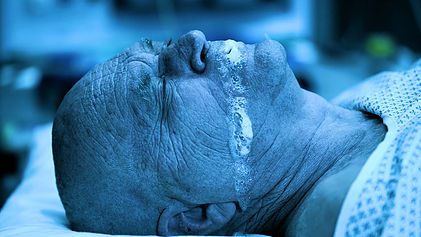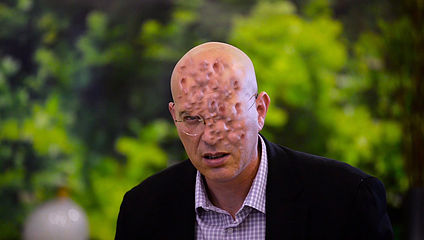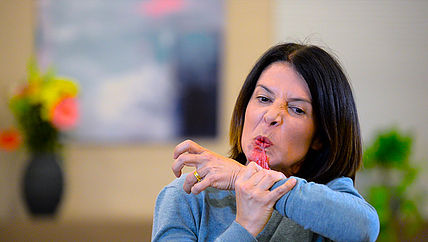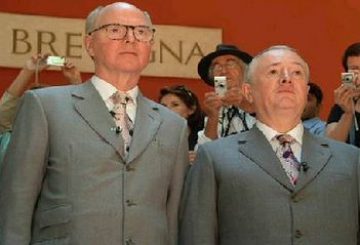In advance of the world premiere of the genre busting ‘The Foaming Node’ at Perth’s Revelation Film Festival this week, Art Life editor Andrew Frost interviews director Ian Haig about body horror, cheap fx and weird new organs…
Andrew Frost: The first question is about the title – what the hell is a Foaming Node?
Ian Haig: The Foaming Node is a 65 min video work, about members of a cult of sorts, who retell their story to an off screen interviewer we never see. The whole video takes place in a kind of banal television-interview style format, which increasing begins to go off the rails and stray into strange territory into a discussion of the human body, technology, transformation, mutation, cannibalism, the discovery of a new human organ… The Foaming Node is a character in a hospital bed, possibly in a coma, who possibly is or isn’t transmitting information to the cult members and controlling their bodies in different ways… Lots of the ideas in The Foaming Node are about the distribution of the human body through different means and other fringe kinds of experiments of the body which are central to the belief system of the cult. The idea of the distribution of the body has a real body horror and violent aspect to it. The body breaking down and re-assembled into something else and the body as both a physical and digital entity, this idea of the body transformed into data, or distributed through blood transfusions, organ donations is central to the whole work. The work is very dialogue heavy with lots of crude digital effects, which are clearly fake but add to the whole weird unreal/real simulation going on in the work, or some kind of digital/software transformation of the body which is taking place.
The Foaming Node trailer, 2018 from ian haig on Vimeo.
AF: Although the effects are deliberately not ‘state of the art’, either CG or SFX make-up etc, yet at the same time, they do have the power to viscerally suggest horror, the abject and the uncanny. What are your thoughts on this kind of ‘cue’ in horror that primes us for a shock, and we still feel it even as we know it’s fake, or in this case, obviously so?
IH: Yes I think there is a physiological aspect to our reading of lots of CG and digital effects, in the sense we know there is a high degree of simulation there, we accept it. This gets into weird territory with horror, can a simulated, computer generated effect in horror really scare, disturb in the same way a physical effect can? if you know there is a high degree of digital simulation and an unreality? I think your right digital effects can evoke ‘cues’ for us to respond to, but in a way these digital cues are really premised on a more physical reality and experience the audience brings to it. This space of artificiality and simulation of the abject and the visceral body is certainly something a lot of my work has explored, in many ways the simulation has become more real than the real thing which I think is fascinating. Colin McGinn calls it ‘quasi-disgust’, a complex make-believe at work and how cinema gives us the pseudo abject, a simulacrum in a way.
AF: What’s the background to this work? How did it evolve and how does it relate to some of the other short videos you’ve recently posted to Vimeo?
IH: I‘ve always made lots of short video pieces over the years, these have always been in the experimental video art genre, often around themes of the confrontation of the body and technology, so the Foaming Node is really an extension of this. However I think deep down I’ve always wanted to make body horror films. In a way the Foaming Node is my very crude attempt at this. Also because I am coming to something like this with more of a video art or experimental background that brings a weirdness to it, it’s not at all a straight up genre piece, it’s something else entirely. Even though the work does connect with elements of horror, or exploitation films, it was also the first time I have ever worked with actors. The project evolved over a year or so, and I always knew I wanted to make it into a long form, feature type thing, so the idea of having it take place all in a TV studio type set up, with members of the cult telling their story began to emerge as the basic framework. The work is in no way cinematic, it’s very much based in this kind of static, artificial televisual look. I was also interested in perverting the bland and banal morning TV style interview as things get increasingly stranger and stranger, that was the basic narrative drive to the video. I think the soundtrack too by The Overtone ensemble adds a degree of intensity and creepiness to what is unfolding.
AF: One of the things that always freaks me out in movies and TV shows is where the fourth wall is broken between television and the audience, either for the characters, or where the actors address the audience directly, Michael Haneke’s ‘Funny Games’ being a classic example. Do you think that that kind of disturbance for the viewer is part of this work, especially given how ‘literate’ people are supposed to be with media now, and how recognisable the tropes of the talking head documentary are?
IH: It’s possibly also a result of my lack of experience in directing actors! But yeah, In this work I actually like the fakery and artificiality of what your referring to, it kind of comes across as wrong, which brings a certain amount of weirdness to it. I was interested in pushing these kinds of things, like the obviously fake CG, the hammy and at times overblown acting to the camera, the artificial TV sets, there is a freaky kind of cartoon, plastic aesthetic that emerges with this stuff, particularly when its not played as ‘funny’ but is entirely serious which I thought was interesting, it certainly pushes against this idea of ‘naturalism’ and instead the artificial/simulated is presented as natural and normal.
AF: Judging by the trailer for The Foaming Node, there’s a really interesting combination of medical documentary, body horror and a suggestion of zombies in the work, and it looks like it could equally be a documentary or a horror film. How do you imagine this work sites in a film festival context?
IH: It’s very hybrid, kind of experimental body horror with elements of experimental Sci-Fi, this is all within the context of a documentary of sorts, but it’s not really a documentary. I like the fact that it’s hard to define what the work is. The video is about human mutation and the work itself is kind of mutant. There are various scenes of people foaming at the mouth, which doesn’t necessarily mean they are zombies, but they are certainly ‘possessed’ in some way, foaming at the mouth is really them channeling the foaming node. There is also this idea in the video of foam as a form of media, which is distributed to other bodies throughout. I feel the work sits within a film festival context, opposed to a gallery however possibly some festivals may find it too experimental and hard to define what it is, or maybe the art world see it as too B-grade. I do like the idea of the theatrical screening for it, as there is a audio/visual intensity to the work which I think is important which a gallery doesn’t really give you in the same way.
AF: I could of sworn I saw a woman gnawing her own wrist in the trailer… Well, given that the work its somewhere between cinema and video art, and there’s a issue of definition that tends to set up the audience in terms of what they might expect, who for you is the ideal viewer? What do we need to bring to this, or leave behind, to appreciate it?
IH: Yes she was doing auto-cannibalism and eating her own flesh. In a way I wanted to make a video/film that I wanted to see, that I wanted to experience. It’s an interesting question and I am not sure where the audience is here! In a way making something like this, there were so many smaller details to consider and occupy my brain: the lighting, the dialogue, the sets, the performances, did I have enough money for lunch for the actors? considering what the audience was going to think, or what they might bring to it was possibly the last on my list! Which I know sounds self indulgent, but I didn’t want to second guess the audience in any way. Everyone consumes so much content these days on streaming services, Netflix, Torrents etc it gets to the point that I cant remember what I watched last week, like I really can’t. I thought if I could make something that at least screwed with people a bit and made them remember it and along the way explore some freaky and interesting ideas that would be ok. Audiences these days consume so many different kinds of things, low/hi, crude/sophisticated, trash/poetic etc…and there are so many complex value systems at work, like B-grade, or even ‘poetic’ depending on what audience your talking too it could either be a negative or positive thing! so audiences I think are very complex in a way. The work is really more a mutant video art work than a ‘real’ film, I mean in many ways it’s almost anti cinematic. However it also doesn’t fulfill the idea of what video art is meant to be, so possibly video art audiences would have a hard time with it, but hopefully it takes the viewer somewhere they haven’t been before. I think it would be interesting for example for someone just to stumble upon it on Netflix, with no information and just experience it.





